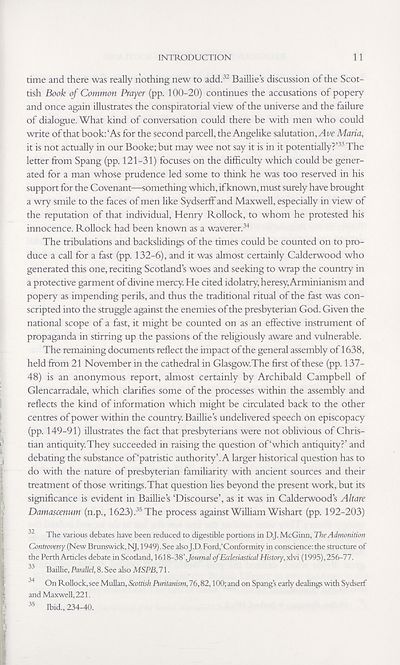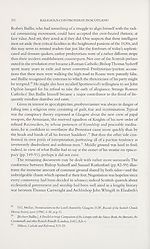Series 5 > Religious Controversy in Scotland 1625-1639
(26) Page 11
Download files
Complete book:
Individual page:
Thumbnail gallery: Grid view | List view

INTRODUCTION
11
time and there was really nothing new to add.32 Baillie s discussion of the Scot¬
tish Book of Common Prayer (pp. 100-20) continues the accusations of popery
and once again illustrates the conspiratorial view of the universe and the failure
of dialogue. What kind of conversation could there be with men who could
write of that book: ‘As for the second parcell, the Angelike salutation, Ave Maria,
it is not actually in our Booke; but may wee not say it is in it potentially?’33 The
letter from Spang (pp. 121-31) focuses on the difficulty which could be gener¬
ated for a man whose prudence led some to think he was too reserved in his
support for the Covenant—something which, if known, must surely have brought
a wry smile to the faces of men like Sydserff and Maxwell, especially in view of
the reputation of that individual, Henry Rollock, to whom he protested his
innocence. Rollock had been known as a waverer.34
The tribulations and backshdings of the times could be counted on to pro¬
duce a call for a fast (pp. 132-6), and it was almost certainly Calderwood who
generated this one, reciting Scotland’s woes and seeking to wrap the country in
a protective garment of divine mercy. He cited idolatry, heresy, Arminianism and
popery as impending perils, and thus the traditional ritual of the fast was con¬
scripted into the struggle against the enemies of the presbyterian God. Given the
national scope of a fast, it might be counted on as an effective instrument of
propaganda in stirring up the passions of the religiously aware and vulnerable.
The remaining documents reflect the impact of the general assembly of 1638,
held from 21 November in the cathedral in Glasgow. The first of these (pp. 137-
48) is an anonymous report, almost certainly by Archibald Campbell of
Glencarradale, which clarifies some of the processes within the assembly and
reflects the kind of information which might be circulated back to the other
centres of power within the country. Bailhe’s undelivered speech on episcopacy
(pp. 149-91) illustrates the fact that presbyterians were not oblivious of Chris¬
tian antiquity. They succeeded in raising the question of‘which antiquity?’ and
debating the substance of‘patristic authority’. A larger historical question has to
do with the nature of presbyterian famfliarity with ancient sources and their
treatment of those writings.That question lies beyond the present work, but its
significance is evident in Bailhe’s ‘Discourse’, as it was in Calderwood’s Altare
Damascenum (n.p., 1623).35 The process against William Wishart (pp. 192-203)
32 The various debates have been reduced to digestible portions in DJ. McGinn, The Admonition
Controversy (New Brunswick, NJ, 1949). See also J.D. Foid,‘Conformity in conscience: the structure of
the Perth Articles debate in Scotland, 1618-38’Journal of Ecclesiastical History, xlvi (1995), 256-77.
33 Baillie, Parallel, 8. See also MSPB, 71.
On Rollock, see Mullan, Scottish Puritanism, 76,82,100; and on Spang’s early dealings with Sydserf
and Maxwell, 221.
35 Ibid., 234-40.
11
time and there was really nothing new to add.32 Baillie s discussion of the Scot¬
tish Book of Common Prayer (pp. 100-20) continues the accusations of popery
and once again illustrates the conspiratorial view of the universe and the failure
of dialogue. What kind of conversation could there be with men who could
write of that book: ‘As for the second parcell, the Angelike salutation, Ave Maria,
it is not actually in our Booke; but may wee not say it is in it potentially?’33 The
letter from Spang (pp. 121-31) focuses on the difficulty which could be gener¬
ated for a man whose prudence led some to think he was too reserved in his
support for the Covenant—something which, if known, must surely have brought
a wry smile to the faces of men like Sydserff and Maxwell, especially in view of
the reputation of that individual, Henry Rollock, to whom he protested his
innocence. Rollock had been known as a waverer.34
The tribulations and backshdings of the times could be counted on to pro¬
duce a call for a fast (pp. 132-6), and it was almost certainly Calderwood who
generated this one, reciting Scotland’s woes and seeking to wrap the country in
a protective garment of divine mercy. He cited idolatry, heresy, Arminianism and
popery as impending perils, and thus the traditional ritual of the fast was con¬
scripted into the struggle against the enemies of the presbyterian God. Given the
national scope of a fast, it might be counted on as an effective instrument of
propaganda in stirring up the passions of the religiously aware and vulnerable.
The remaining documents reflect the impact of the general assembly of 1638,
held from 21 November in the cathedral in Glasgow. The first of these (pp. 137-
48) is an anonymous report, almost certainly by Archibald Campbell of
Glencarradale, which clarifies some of the processes within the assembly and
reflects the kind of information which might be circulated back to the other
centres of power within the country. Bailhe’s undelivered speech on episcopacy
(pp. 149-91) illustrates the fact that presbyterians were not oblivious of Chris¬
tian antiquity. They succeeded in raising the question of‘which antiquity?’ and
debating the substance of‘patristic authority’. A larger historical question has to
do with the nature of presbyterian famfliarity with ancient sources and their
treatment of those writings.That question lies beyond the present work, but its
significance is evident in Bailhe’s ‘Discourse’, as it was in Calderwood’s Altare
Damascenum (n.p., 1623).35 The process against William Wishart (pp. 192-203)
32 The various debates have been reduced to digestible portions in DJ. McGinn, The Admonition
Controversy (New Brunswick, NJ, 1949). See also J.D. Foid,‘Conformity in conscience: the structure of
the Perth Articles debate in Scotland, 1618-38’Journal of Ecclesiastical History, xlvi (1995), 256-77.
33 Baillie, Parallel, 8. See also MSPB, 71.
On Rollock, see Mullan, Scottish Puritanism, 76,82,100; and on Spang’s early dealings with Sydserf
and Maxwell, 221.
35 Ibid., 234-40.
Set display mode to:
![]() Universal Viewer |
Universal Viewer | ![]() Mirador |
Large image | Transcription
Mirador |
Large image | Transcription
Images and transcriptions on this page, including medium image downloads, may be used under the Creative Commons Attribution 4.0 International Licence unless otherwise stated. ![]()
| Scottish History Society volumes > Series 5 > Religious Controversy in Scotland 1625-1639 > (26) Page 11 |
|---|
| Permanent URL | https://digital.nls.uk/127328277 |
|---|
| Description | Over 180 volumes, published by the Scottish History Society, containing original sources on Scotland's history and people. With a wide range of subjects, the books collectively cover all periods from the 12th to 20th centuries, and reflect changing trends in Scottish history. Sources are accompanied by scholarly interpretation, references and bibliographies. Volumes are usually published annually, and more digitised volumes will be added as they become available. |
|---|


